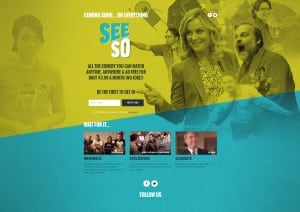By David Teich
Seeso aims to disrupt the disruption with an OTT experience that gives choice back to the consumer. Evan Shapiro, EVP of NBCUniversal Digital Enterprises, oversees the ad-free streaming comedy channel, which made its Beta preview this month.
Cynopsis: The NBC library has mountains of content spanning multiple genres.  Why did you decide to focus on comedy?
Why did you decide to focus on comedy?
Evan Shapiro: We did around 10,000 interviews with consumers who watch video online, and we used those interviews to inform a lot of the choices that we made. We found that around 75 or 80% of all consumers list comedy as their number one genre. We also found that, amongst people most likely to subscribe to a brand new service, 90% said comedy was their number one genre. And they often said that there’s a lot of great comedy content out there that they look for and can’t find, stand-up being a prime example.
Cynopsis: One of Seeso’s biggest innovations is its interface: As soon as a user pulls up the channel, video automatically starts playing. But the channel’s content is also easily searchable. You’ve called Seeso a combination of the best features of both OTT and linear TV. What made you decide to design the channel that way?
Shapiro: There’s a conventional wisdom that all linear TV is bad, and all OTT is good. And neither of those things is absolutely true. We wanted to keep the things that people really dig about the linear experience. And we wanted to get rid of the things that people don’t like about OTT. Our major innovations are all built around creating the single most enjoyable experience you can find…I think we’re about to see the disruption disrupted. In the first generation of OTT, making OTT as different from “television” as possible was one of the key goals. The disruption was the idea that you could have access to content anywhere and anytime. That was the major innovation. And then it felt like things just stopped. The experiences became a bit cluttered. And the time [it takes] to view is actually getting longer, not shorter.
Cynopsis: What caused it to get longer?
Shapiro: There are a couple of different factors at play there. First of all, when you log on to other OTT services, nothing is playing, unless you’re in the middle of a binge. For the most part, when you log on, you have to search. These experiences have become work, frankly. And there’s just an endless sea [of content]. When you’ve got Dora the Explorer and Transformers and horror movies all on one platform, you think, “God, what the [expletive] am I watching?”
 Cynopsis: So it’s easy to see why it can be valuable to zero in on a specific genre, and to make sure content is playing as soon as you bring up the channel.
Cynopsis: So it’s easy to see why it can be valuable to zero in on a specific genre, and to make sure content is playing as soon as you bring up the channel.
Shapiro: There’s a reason why the Food Network exists—it’s because you’re in the mood to watch some food. We went along with that approach: creating a big niche destination where something’s playing when you log on, and it doesn’t really matter what from the channel is playing, because the reason you’re there is that you’re in a specific mood. That’s just like TV: big niche, and automatic play.
Cynopsis: How else is Seeso like TV?
Shapiro: Well, even while that content is automatically playing, you can still hunt for your next piece of content. That’s just like the IPG [interactive program guide] on cable.
Cynopsis: It’s very true that it’s easy to just search endlessly on an OTT service, without ever being able to settle on anything to watch. The automatic play approach might just keep a user from going crazy.
Shapiro: That’s exactly right. Sometimes you just want a passive experience. Maybe it’s a Friday night, it’s been a long week, you’ve got a glass of wine in front of you. When you turn on your television set, you just want something provided to you. But you want it to be of a certain mood, and that’s really where we come from: We’ve curated a list for you to passively put on. Or you can search for something new. It’s up to you. With so many OTT players, there’s a paradox of choice at play. These players that are all about “consumer choice” have really taken the choice away from the consumer. They force the binge-watch, when sometimes it’s great to watch things one week at a time. They force you to search, when sometimes you just want to lean back. Seeso gives consumers absolute choice.
Cynopsis: When it comes to hiring, have you tended to favor people from OTT backgrounds, or from TV backgrounds?
Shapiro: We’ve really lifted people from across the industry. We’ve stolen staff from a number of the other OTT players. My Head of Business comes from Xbox and Netflix. My Head of Marketing and Consumer Experience comes from Shazam and Hulu. Her number two comes from Netflix. Our Head of Product comes from Crackle. And then we have a lot of great TV people as well.
Cynopsis: The channel has a vast array of content. How did you go about selecting it?
Shapiro: We call it “mapping the comedy genome.” We started with the classic NBC comedy DNA: SNL and The Office at the core of it. And then it branches out in a kind of family tree from there. That’s also where the name came from, by the way: You came here to SEE Saturday Night Live, SO we’ll also show you Monty Python. You came here to SEE The Office, SO we’ll also show you the original Office. And while we’re at it, we’ll also show some other great classic office comedy, and some great British comedies that you probably haven’t seen before. You can kind of connect everything—it all has a sort of a lineage to it. And you say the array is vast, but it’s also orderly. It’s not rigid, but there’s a sense of gravity in the universe. In a way, checking out some of these other OTT retail environments is like walking into CostCo stoned off your ass. And I don’t really know what that’s like, because I’ve never been in a CostCo. [Laughs.] But we give you a sense of order.
Cynopis: And how have you gone about selecting the original content?
Shapiro: UCB [Upright Citizens Brigade] is really at the center of the original stuff. UCB in New York and Los Angeles has created…the best and brightest minds in comedy right now. We also take pitches from comedians and writers and producers all the time, and what we hear is,  “Jesus Christ, all my friends are working with you. We felt we had to come in.” As for selection, we came up with our filter first, and then our dream list of artists second. That’s how I typically do things. Our filter is “funny, audacious, and authentic.” And we put that into one wrapper called “right-brain comedy.” Then we went after artists who represent that to us, Dan Harmon probably chief among them…And we also looked for influencers.
“Jesus Christ, all my friends are working with you. We felt we had to come in.” As for selection, we came up with our filter first, and then our dream list of artists second. That’s how I typically do things. Our filter is “funny, audacious, and authentic.” And we put that into one wrapper called “right-brain comedy.” Then we went after artists who represent that to us, Dan Harmon probably chief among them…And we also looked for influencers.
Cynopsis: What kinds of influencers?
Shapiro: I know the word “influencers” is thrown around a lot. When most television executives use that word, they’re really mimicking this idea of Viners and YouTubers and Instagrammers. What we wanted was influencers in professional comedy. When you look at Dan Harmon or Jonah Ray, or Cameron Esposito, or Scott Aukerman, or Matt Besser—the work coming from that crowd isn’t just impressive in its quality. These people are also enormously prolific storytellers. This is about being funny in a long form, and doing so with an audience, on a consistent basis, over a long period of time. That’s hard. Dying is easy, comedy is hard.
Cynopsis: In the last few years, digital influencers—amateurs, some might say—have been more and more empowered in the digital space. But it seems like that’s something you wanted to avoid.
Shapiro: [Seeso] is not a place for amateurs. There was a lot of temptation to go into the YouTube world, to pick up Viners. But we wanted pros, so we only have pros. Even our short-form is done by pros. Our daily dose of stand-up is exclusive, it’s original. It’s professional comedians doing their work. There’s no one on the channel who’s [expletive]-ing around. I have great respect for the PewDiePies and Grace Helbigs of the world. They are pros now. But the vast majority of content that is created on all these platforms comes from people who, yes, are being paid, but aren’t being forced to do long-form content on a regular basis. We want people who know how to create long-form storytelling in a comedic form, regularly, on time, on budget, and who understand what it’s like to be a professional comedian.
Cynopsis: In just a few sentences, what would you say is unique about the experience of using Seeso?
Shapiro: There’s a famous record store in Atlanta called Wuxtry Records. And that’s the experience we’re looking to create: That corner record store where you go in, and you know that the people behind the counter know where the good stuff is. They know what you like to listen to, and they take a great deal of care in recommending the coolest stuff that you’ll be able to find—whether you’ve heard it before and this is a new version of it, or whether it’s stuff that you just need to listen to. There’s a kind of vinyl approach to what we’re doing. Actually, In the Seeso mnemonic—our sort of audio brand—you can hear a needle drop brush at the beginning, and then a digital sound on the back end. We want to marry the beauty of analogue to the convenience and wow factor of digital.







